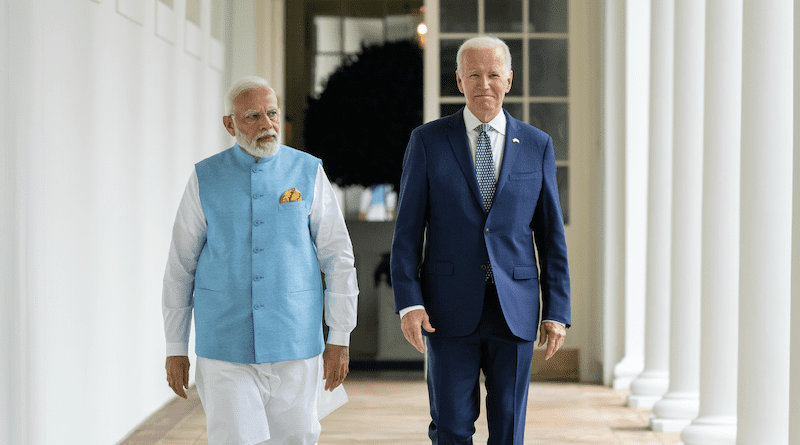Indispensable India: How Modi’s Visit Recalibrated Power Balancing Between US And Russia – Analysis
Much buzz was made on the big takeaway by India during the recent visit to USA by the Indian Prime Minister Narendra Modi. The American political analysts were upbeat for growing ties between India and USA, irrespective of Russia re-emerging a stronger political and economic partner.
India is not an important trading partner of USA. Neither, it is a political ally or major buyer of defence equipment from USA. Even then, India has been reckoned indispensable to the USA.
White House Press Secretary Karine Jean Pierre said, “We see….the Indian partners as indispensable. And the US-India strategic Partnership is grounded in our shared commitment to the advancement of free and open India-Pacific region.
The noted economic journal The Economist, released a special issue, chanting “India is indispensable to USA”.
India’s neutral stand on the Russian invasion of Ukraine exasperated the true lovers of democratic Americans. Even then, the USA was over enthusiastic to foster closer ties with India.
The key issue influencing the American foreign policy aberration could be the rising rivalry to China and India’s growing hostility to China, at the same time.
Historically , India and USA have never been that deep or close in the political relation. But, America realized that to intensify rivalry to China, India is indispensable. This is because India’s leadership in Indo-Pacific area is more emphatic than USA to contain China. The Economist said “Its recent foreign policy has become more assertive and hostile to China”.
Besides, India’s spurring economic growth and challenges for alternative supply chain might have impressed American policy makers
During Modi’s visit to USA, nearly 20 to 25 areas of technical cooperations were identified. They included semiconductors, quantum science, defence, space. Most of these agreements manifest to increase India’s defence power as proxy and alternative supply chain to China. For example, Micron Technology entry in India for manufacturing micro chips will pose a challenge to China and GE’s manufacturing of jet engine for fighters in India is likely to be a bet for proxy defence power.
Micron Technology, USA, has decided to set up a plant for manufacturing micro chip in Gujarat. It will invest US$825 million. This is the second agreement for setting up micro chip plant in India after Vedanta-Foxconn micro chip plant, which will go into operation by 2027. Currently, India does not have micro chip plant.
According to Bloomberg Intelligence (BI), USA’s dependency on Chinese technology supply chain could be reduced by 40 percent by 2030.
In defence, joint production facilities will be escalated with GE Aerospace for jet engine for fighters and India will buy General Automatic MQ-9 “Reaper” Drones.
In January 2023, a mega agreement was signed with USA, namely “The Critical and Emerging Technology Initiative” (iCET) as strategic partnership in advanced weaponry, supercomputing, semiconductors and other high technologies.
Under the agreement, a roadmap was drawn for enhancing USA-India collaboration in critical and emerging technologies. It includes development of AI, semiconductor ecosystems to ensure supply chain, advancement of 5G and 6G and Open RAN Network Technology in India for a open and secure telecom infrastructure.
USA is the biggest investor in India. Its diaspora are more influential in USA than any other non-Americans. It is the biggest destination for India’s IT exports and the biggest pool for Indian IT emigrants in America.
India-Russia relations have undergone profound changes after the collapse of Soviet Union. The relation slipped both in defence and trade sectors, after India bent towards west and USA for defence cooperations and arms supplies.
In the post Soviet Union collapse , a juxtapose situation arose with uprise in the relations between India, USA and the west vis-a vis growing rivalry between India-China. This left India-Russia relations on the back bench. The Ukraine war and the sanctions opened a new era for the revival of India-Russia relations.
The energy needs become the main intervening factor for the resurrection of India-Russia relations. Russia emerged as a new source of oil imports. It raised the hope for nixing the oil volatility, owing to frequent rises in oil prices by OPEC.
In 2022-23, India’s imports of crude oil from Russia increased by over 1,054 percent (from 4.3 million tonne in 2021-22 to 50.8 million tonne in 2022-23). It accounted for more than 20 percent of total import of crude oil in 2022-23, as compared to 2 percent in the preceding year. India saved US $ 3.6 billion in the import of oil from Russia, which was offered at discounted rate.
As a result Russia re-emerged a potential rising trading partner of India. It became the 5th largest trading partner of India in 2022-23.
Besides, India’s volta-face to USA and EU sanctions became the benchmark for revival of India-Russia relations. India’s abstaining from voting against Russia in UN General Assembly as well as in UN Security Council for invasion in Ukraine, manifest India’s sovereignty in the global political dynamism .
In summing up, both USA and Russia are both indispensable. On the one hand, closer ties with USA is imperative for India’s hegemony in IPEF (Indo-Pacific Economic Forum), a new era in the global leadership, coupled with defence and technology upgradation for an alternative supply chain to contain China and on the other hand, Russian cooperation is essential to de-risk oil volatility.

